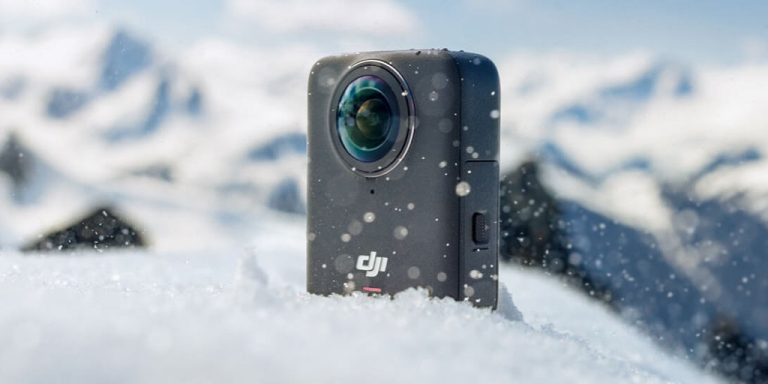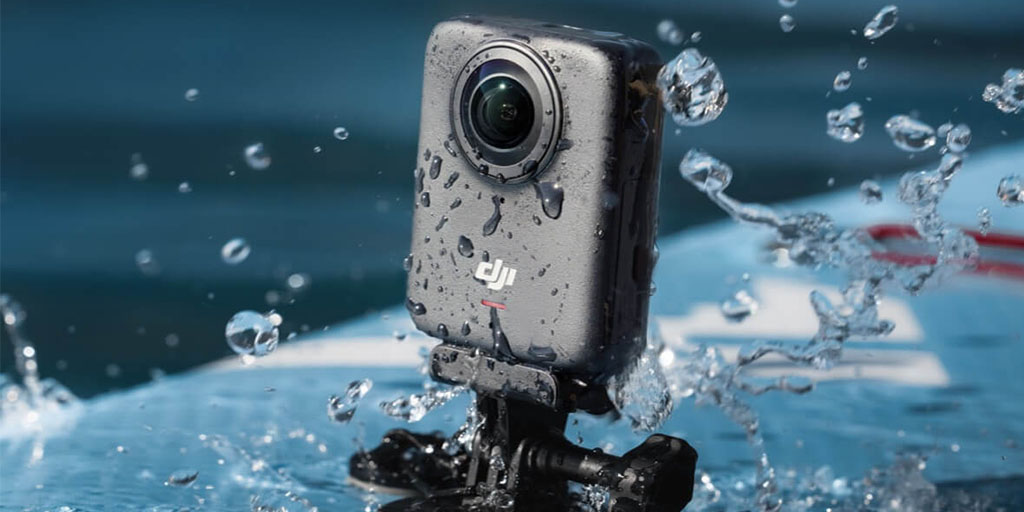DJI Osmo 360 Launches, Aims to Dethrone Insta360’s Flagship 360 Camera


DJI – best known for its drones and action cameras – has officially entered the 360-degree camera market with the Osmo 360, launched on July 31, 2025. This release marks DJI’s first foray into fully spherical cameras.
The Osmo 360 arrives with bold claims: it’s the first 360 camera to offer native 8K video at 50 frames per second and the only one capable of recording 8K footage continuously for up to 100 minutes. It also introduces an “industry-first” pair of 1-inch-type sensors designed specifically for 360 capture – a larger, square sensor format that DJI says uses 25% more of the sensor area than traditional designs, aiming to deliver superior image quality and low-light performance.
In a press statement, DJI signaled its intent to shake up this niche. “With the Osmo 360, DJI is challenging the status quo of the 360 camera market,” said Christina Zhang, the company’s Senior Director of Corporate Strategy. The new camera is positioned to elevate industry standards for immersive imaging with its high-resolution video and large sensors, directly targeting the current category leader, Insta360, and its popular X5 .
The Insta360 X5 has long been regarded as one of the best consumer 360 cameras, so DJI’s move raises the question: can the DJI Osmo 360 dethrone Insta360’s flagship?
High-End Specs and Features
The DJI Osmo 360 is a compact, dual-lens 360° camera packed with premium specifications. Each lens module houses a roughly 1-inch sensor (effectively 1/1.1-inch) – notably larger than the 1/1.28-inch sensors in the Insta360 X5 – and with pixels twice the size of those in the X5 (2.4μm vs 1.2μm)t. In theory, these oversized pixels should translate to cleaner low-light images and wider dynamic range. Indeed, DJI touts the Osmo 360’s 13.5 stops of dynamic range and f/1.9 aperture as enabling “crisp, vibrant footage” even in challenging lighting.
When it comes to video and photos, the DJI Osmo 360 pushes the envelope. It can capture 8K spherical video at up to 50fps – a step beyond the X5’s 8K 30fps limit – and supports 10-bit color depth with a flat D-Log profile for pro-level editing. For slow-motion or fast action, it can drop to 4K resolution and shoot at 100fps in 360 mode, or even 4K/120fps in a cropped “Boost” mode for a wide action-cam-style view.
Stills photographers aren’t left out either: the DJI Osmo 360 can snap 120-megapixel 360° photos, far eclipsing the 72MP stills from the Insta360 X5. These paper specs suggest more detail and color fidelity from DJI’s camera in both video and photo realms.
Beyond resolution, DJI has baked in a suite of stabilization and AI-powered features to appeal to creators. The Osmo 360 uses the company’s latest stabilization tech – HorizonSteady – to keep 360° footage level to the horizon no matter how the camera is rotated, and RockSteady 3.0 to steady footage in single-lens (action cam) mode.
Early hands-on, field-test reviews indicate the stabilization and automatic horizon leveling are highly effective. The camera also offers intelligent subject tracking and convenient controls like voice commands and gesture control (you can start/stop recording with a hand gesture) for easier operation.
Additionally, DJI’s mobile and desktop apps (Mimo and the new Studio software) support advanced editing functions, including a “GyroFrame” mode that uses the camera’s motion data for creative re-framing of 360 footage.

DJI Osmo 360 Early Impressions from the Field
Initial reviews of the DJI Osmo 360 paint a picture of a polished and promising debut. After testing the camera, a reviewer noted that, for a first attempt, the DJI Osmo 360 delivers great all-round performance with a user-friendly design and solid companion software.
Crucially, other reviews found image quality to be excellent for a 360 camera, with sharp 360° videos and rich colors in bright daylight. The large sensors and DJI’s image processing seem to pay off with high-quality output, although a bit of over-sharpening and saturation were observed in default settings.
Reviewers have also praised DJI’s integration of features from its broader product ecosystem. The DJI Osmo 360 includes 105GB of internal storage on top of a microSD card slot, meaning users can record a substantial amount of footage even without a memory card – a convenient advantage over the X5, which relies solely on external storage.
And for audio, DJI leveraged its expertise in wireless microphones: the DJI Osmo 360 can directly interface with DJI’s own Mic 2 and Mic Mini transmitters, feeding high-quality wireless audio into your 360 videos without an external receiver. This kind of seamless accessory compatibility underscores how DJI is playing to its strengths to entice existing DJI users.
At the same time, early testers caution that the DJI Osmo 360 isn’t a total Insta360 X5 killer – at least not yet.
In side-by-side comparisons, the new Osmo held its ground on standard 360 video quality but doesn’t outright beat the X5 on image quality despite the bigger sensor on paper. Low-light video, for instance, was good but not a dramatic leap beyond the X5’s performance.
Insta360’s mature processing and optics still give the X5 a slight edge in certain scenarios, and that existing X5 owners likely won’t feel compelled to switch. In short, DJI’s debut is extremely compelling and narrows the gap, but the battle for 360-camera supremacy is far from a blowout.

Five Ways the DJI Osmo 360 Surpasses the Insta360 X5
Despite the X5’s strong track record, the Osmo 360 brings several clear advantages to the table:
1. Larger Sensor & Low-Light Performance:
The DJI Osmo 360’s twin 1-inch-type sensors (with 2.4μm pixels) are physically larger than the X5’s 1/1.28-inch sensors (1.2μm pixels), giving DJI a potential edge in image quality.
In theory, the bigger pixels capture more light and detail with less noise, yielding cleaner footage in low-light situations and greater dynamic range. DJI explicitly touts its sensor design as an industry first that offers “outstanding low-light performance” and better use of the imaging area.
While real-world tests show the difference isn’t night-and-day, this sensor advantage positions the Osmo 360 as the more noise-resistant and light-hungry camera for 360° shooting in challenging lighting.
2. Higher Resolution & 10-bit Video
When it comes to output specs, the DJI Osmo 360 pushes beyond the X5. It can record 8K 360° video at up to 50 fps, whereas the Insta360 X5 tops out at 8K 30 fps. That higher frame rate in 8K means smoother motion in ultra-high definition captures.
The DJI Osmo 360 also supports 10-bit color depth (with DJI’s D-Log M flat profile) for greater color gradation, compared to the X5’s 8-bit limit. This gives professionals more flexibility in post-production to extract detail from highlights and shadows. Additionally, DJI’s newcomer can shoot massive 120-megapixel still photos, substantially trumping the 72MP stills from the X5.
For content creators chasing maximum resolution and image data, the DJI Osmo 360 holds a clear advantage on paper.
3. Stabilization and Smart Features
Both cameras offer excellent stabilization, but DJI has leveraged its action-cam heritage to pack in top-tier tech. The Osmo 360 features HorizonSteady stabilization, which locks the horizon level regardless of how the camera twists or rolls, ensuring level footage even during chaotic action.
In single-lens (non-360) mode, DJI’s RockSteady 3.0 system provides rock-solid shake reduction comparable to the best action cams. The Insta360 X5 also has very good stabilization (Insta360’s FlowState algorithm) and horizon leveling, but DJI’s implementation is earning praise for its reliability in testing. On the software side, DJI has added AI-driven tools like built-in gesture control (so you can start recording with a wave of your hand) and voice commands, as well as an intelligent subject tracking mode that can automatically follow people or objects in the 360° frame.
These ease-of-use features offer a level of hands-free control and creative assist that give the Osmo 360 a modern, smart edge – whereas Insta360’s equivalent features mostly live in its editing app rather than in-camera.
4. Built-in Storage & Ecosystem Integration
One immediately practical advantage of the Osmo 360 is its built-in 105 GB internal storage in addition to a microSD slot. This means users can shoot for extended periods (over an hour of 8K footage) without worrying about swapping cards, and they have a safety net if they forget to insert an SD card.
The Insta360 X5, by contrast, has no internal storage and relies solely on external memory cards. Furthermore, DJI has made the Osmo 360 compatible with its existing ecosystem of accessories. It has a magnetic quick-release mount that works with many DJI Osmo Action series mounts and an industry-standard tripod thread for broader compatibility. Notably, for audio, DJI allows direct wireless connection to its DJI Mic 2/Mic Mini system.
This direct pairing (without any dongles or adapters) lets creators capture high-quality sound with ease – a convenience and audio-quality edge for Osmo 360 users, especially those who already own DJI microphones.
Note: Insta360 only very recently introduced a wireless mic accessory for the X5, the Insta360 Mic Air, but it isn’t as full-featured as DJI’s solution and requires a receiver dongle.
5. Price Advantage (Value Proposition)
DJI has priced the Osmo 360 aggressively against its rival. In regions where it’s available, the Osmo 360 undercuts the Insta360 X5 significantly on pricee. For example, in the UK the Osmo 360 starts at £409.99 for the standard bundle, whereas the Insta360 X5 launched at £519.99 (and $549.99 in the U.S.).
That makes DJI’s device notably cheaper for a similar (or even more advanced) spec sheet.
DJI is clearly using price as a tactic to lure potential buyers, offering a premium 360 camera experience at a lower cost of entry than its main competitor. For budget-conscious enthusiasts or those who don’t need the X5’s few extra perks, the Osmo’s value-for-money is a strong selling point.

Two Ways the DJI Osmo 360 Falls Short
While DJI’s newcomer packs plenty of strengths, it doesn’t win in every category. Early comparisons point out a couple of areas where the Insta360 X5 still holds an edge:
1. Durability & Lenses
The Insta360 X5 is regarded as more adventure-ready, thanks largely to a unique design feature: user-replaceable lenses. If the X5’s bulbous lenses get scratched or cracked – a known risk in 360° photography – they can be swapped out for new ones, rather than replacing the entire camera.
In fact, the X5 is currently the only 360 action camera with this replaceable lens option. By contrast, the Osmo 360’s lenses are fixed and not removable (like most 360 cams). That means a serious lens scratch on the Osmo could be a costly accident, essentially requiring a whole-unit repair or replacement.
DJI does include stick-on clear lens protectors in the box and touts an IP68 rugged builds, so as a reviewer commented, if you scratch a lens, you’ll need to replace the whole camera. The DJI Osmo 360 isn’t quite as rugged or forgiving of mishaps as its Insta360 rival.
For extreme sports users or travelers, this difference could tilt the durability advantage to Insta360.
2. Battery Life (Extended Use)
Both the Osmo 360 and Insta360 X5 are capable of lengthy recording times, but the X5 can eke out a bit more endurance, especially with recent updates. DJI claims the Osmo 360 is the first 360 camera that can shoot 8K/30fps continuously for ~100 minutes on a single charge.
That is impressive, yet Insta360 answered with a firmware update enabling a new “Endurance Mode” for the X5, pushing its 8K recording time to just under two hours. Additionally, Insta360 offers an optional high-capacity “Ultra” battery (2,800 mAh, vs the X5’s standard 2,400 mAh) that extends recording time by roughly 17% beyond the stock battery.
In raw capacity, DJI’s battery is actually smaller (1,910 mAh) than the X5’s, though DJI’s power management is efficient enough to hit that 100-minute mark. The bottom line is that for marathon shooting sessions, especially at high resolutions, the Insta360 X5 can last a bit longer in the field.
Battery life remains an area where the DJI Osmo 360 doesn’t clearly surpass its rival – and heavy users might still favor the X5’s extended endurance (and the availability of spare or bigger batteries) for peace of mind.
3. Availability
At launch, DJI confirmed that the DJI Osmo 360 would not immediately be sold in the United States through official channels, a move that has puzzled observers. (By contrast, Insta360’s products, including the X5, are readily available in the US and globally.) DJI has not provided a timeline for a U.S. release, though it’s offering the camera in other markets like Europe and Australia.
This limitation means that, for now, American consumers keen on the DJI Osmo 360 have to import it or buy through third-party retailers – an extra hurdle that Insta360 doesn’t face. The lack of U.S. availability at launch is a temporary shortcoming for DJI, though one unrelated to the device’s performance.
Outlook
In the 360 camera world, competition is heating up, and DJI’s Osmo 360 appears to be the most serious challenger yet to Insta360’s dominance. With its ambitious dual 1-inch sensors, 8K50 video, and creator-friendly features, the Osmo 360 brings a breath of fresh innovation to a market that Insta360 had largely owned in recent years.
Early hands-on impressions indicate DJI has nailed the fundamentals: image quality, stabilization, software – making the DJI Osmo 360 a compelling option for anyone looking to capture immersive content. Its aggressive pricing and the draw of DJI’s ecosystem only add to its appeal.
That said, Insta360’s X5 isn’t standing still. It retains advantages in battery longevity and rugged lens design, and it has the benefit of a proven track record. In fact, the X5’s rugged build, replaceable lenses, low-light performance, ease of use, and battery life keep it ahead of the DJI Osmo 360, according to one reviewer.
For consumers, this rivalry is a win-win: it’s driving rapid improvements and more choice in high-end 360° cameras. As DJI refines its newcomer (and if it resolves regional availability issues), we could see a true shake-up in the 360-camera pecking order.
For now, DJI’s Osmo 360 has arrived as a formidable new contender, signaling that the race to capture every angle just got a lot more interesting.
Featured image: DJI.
